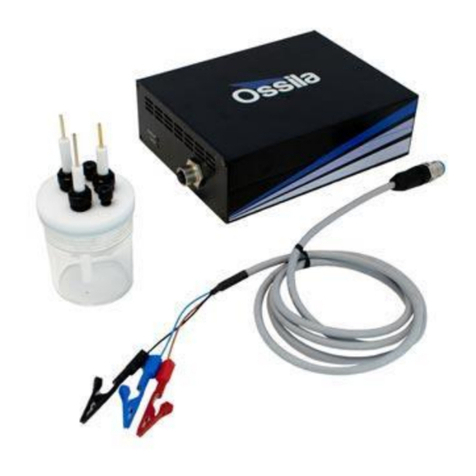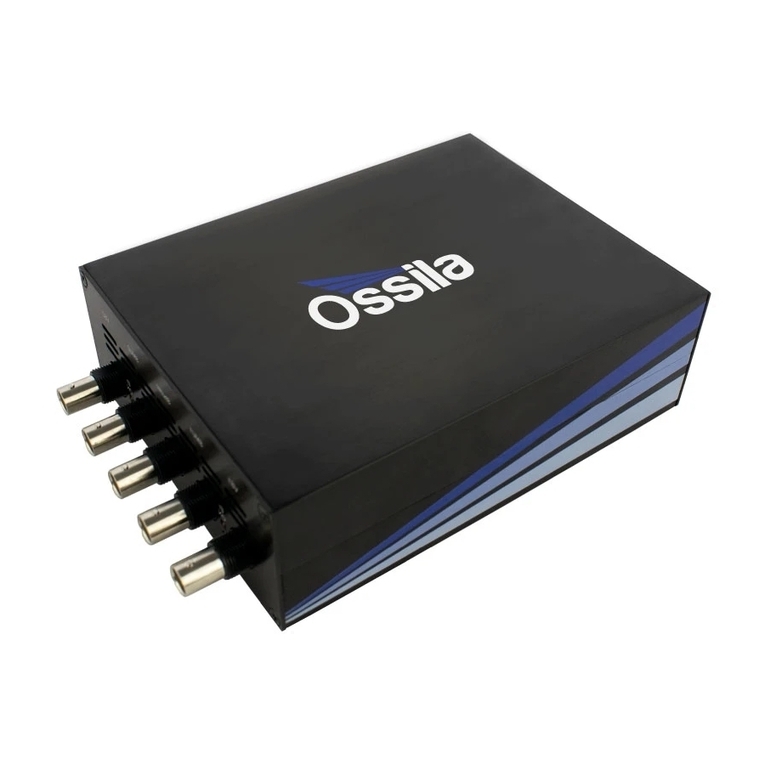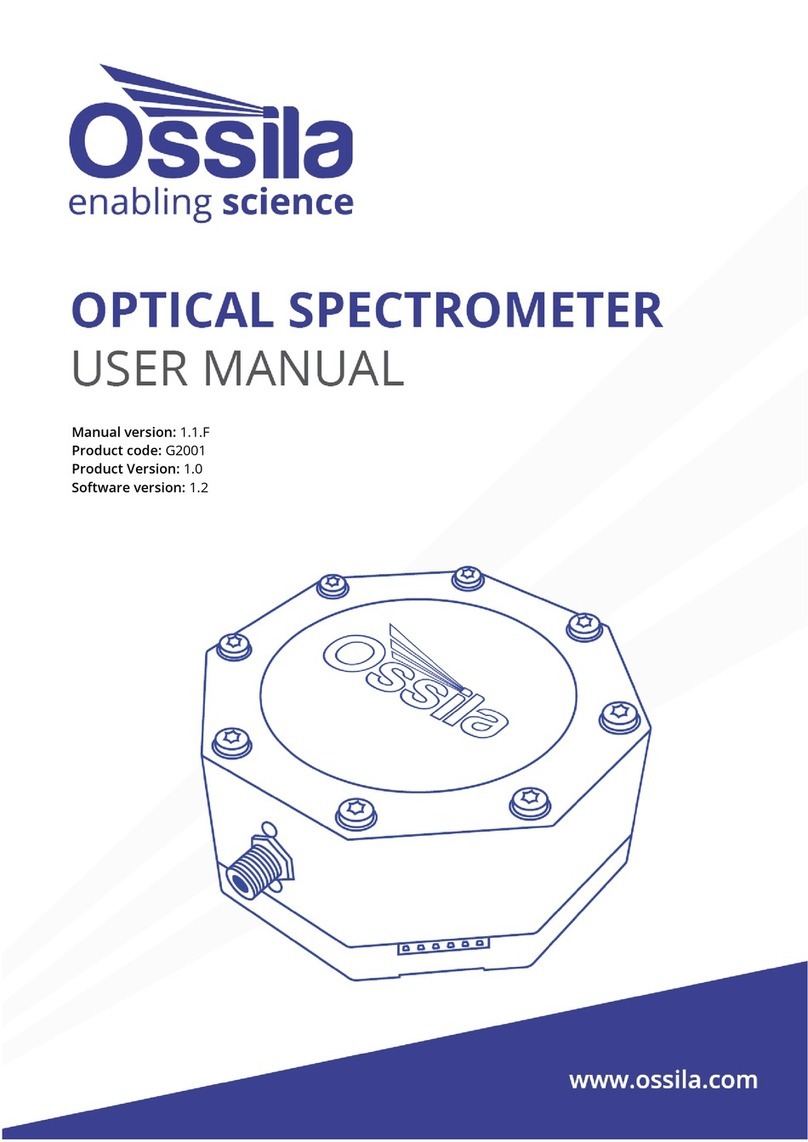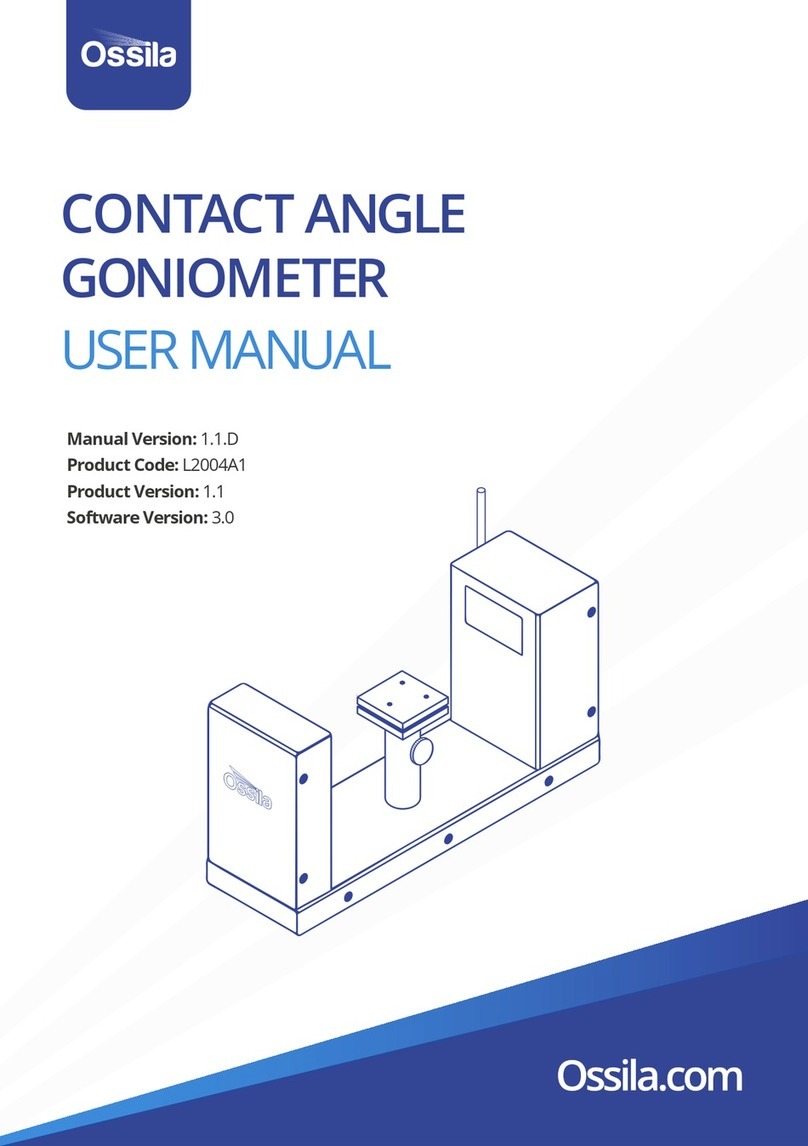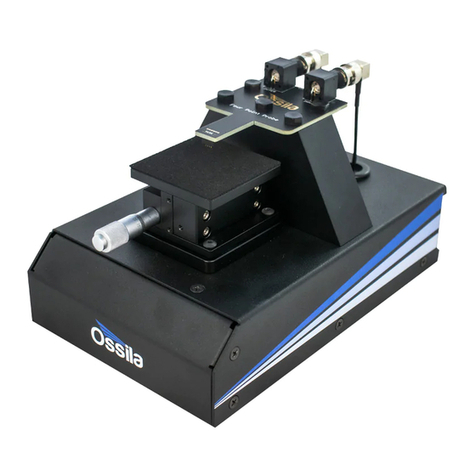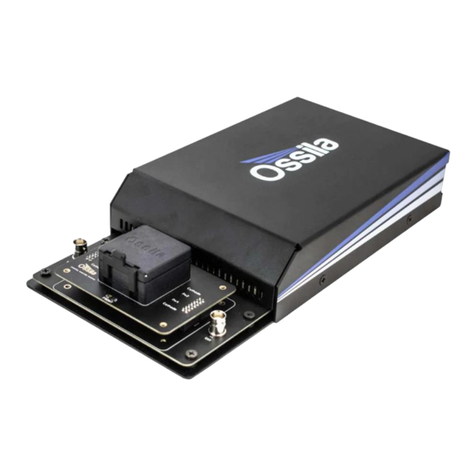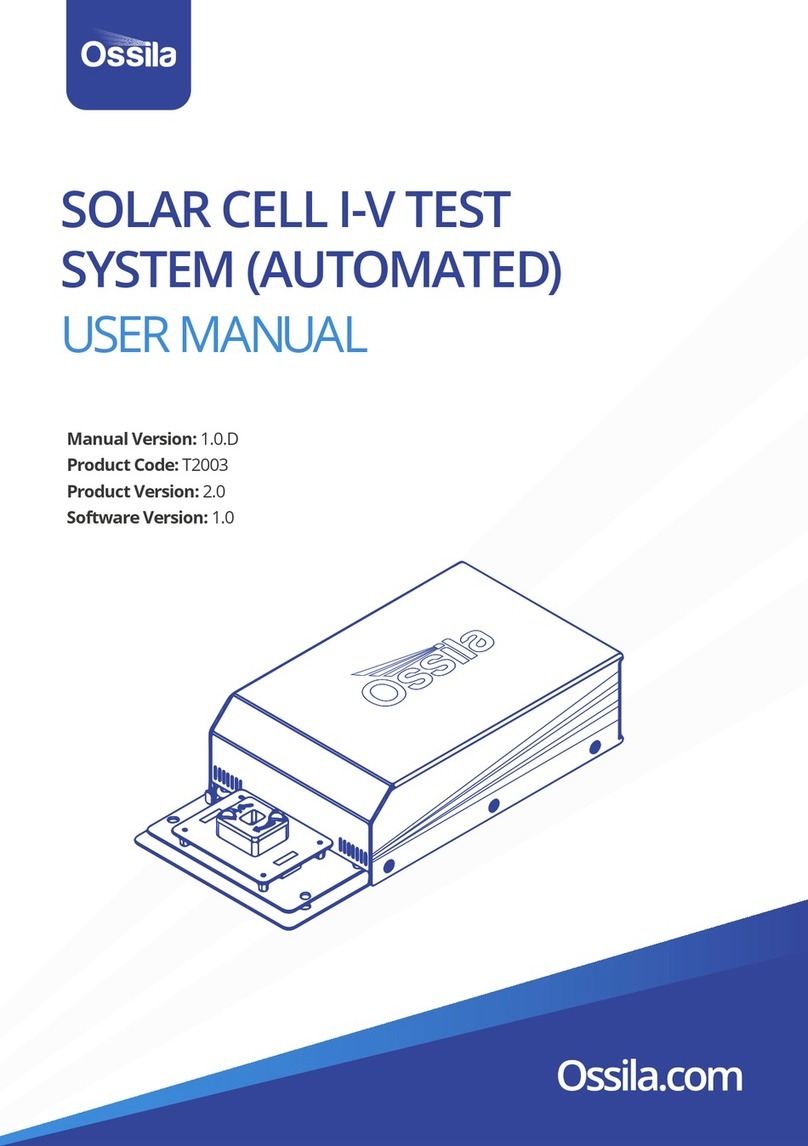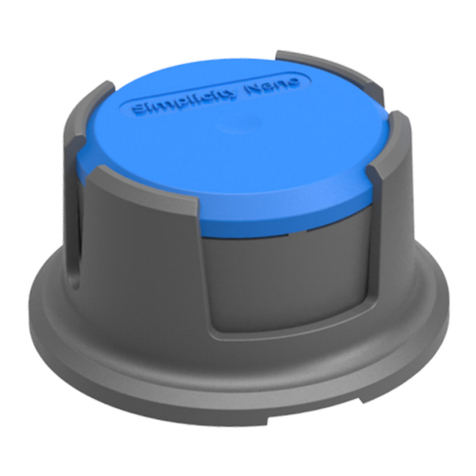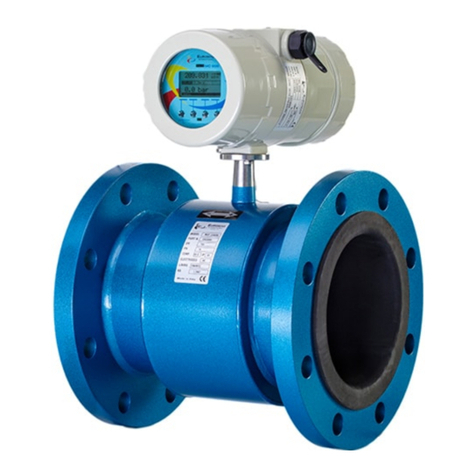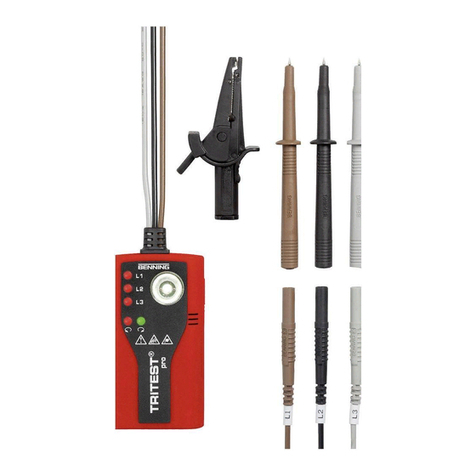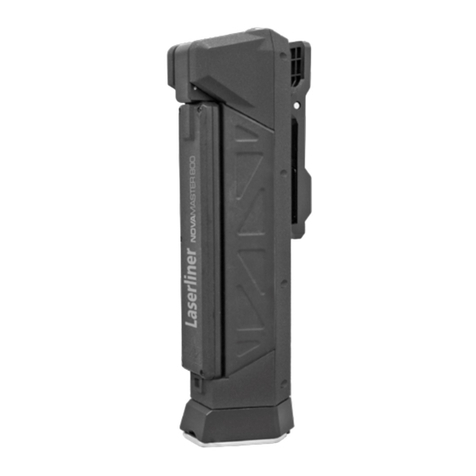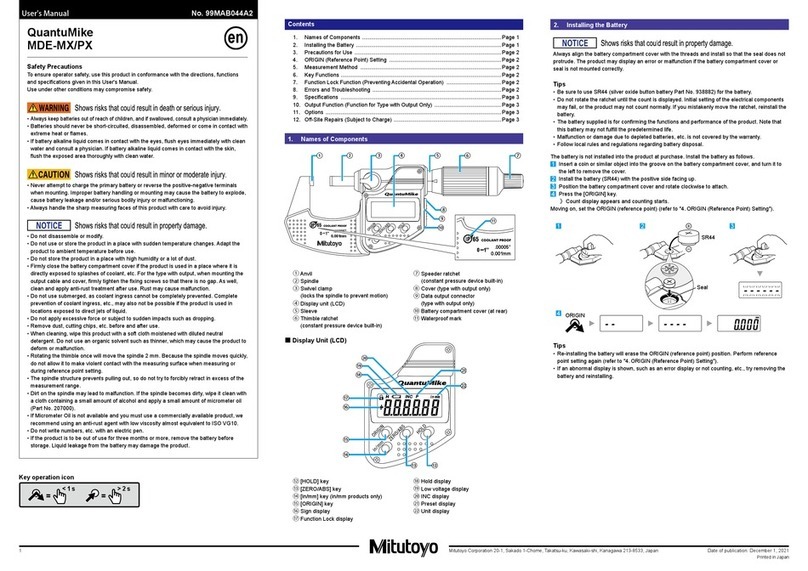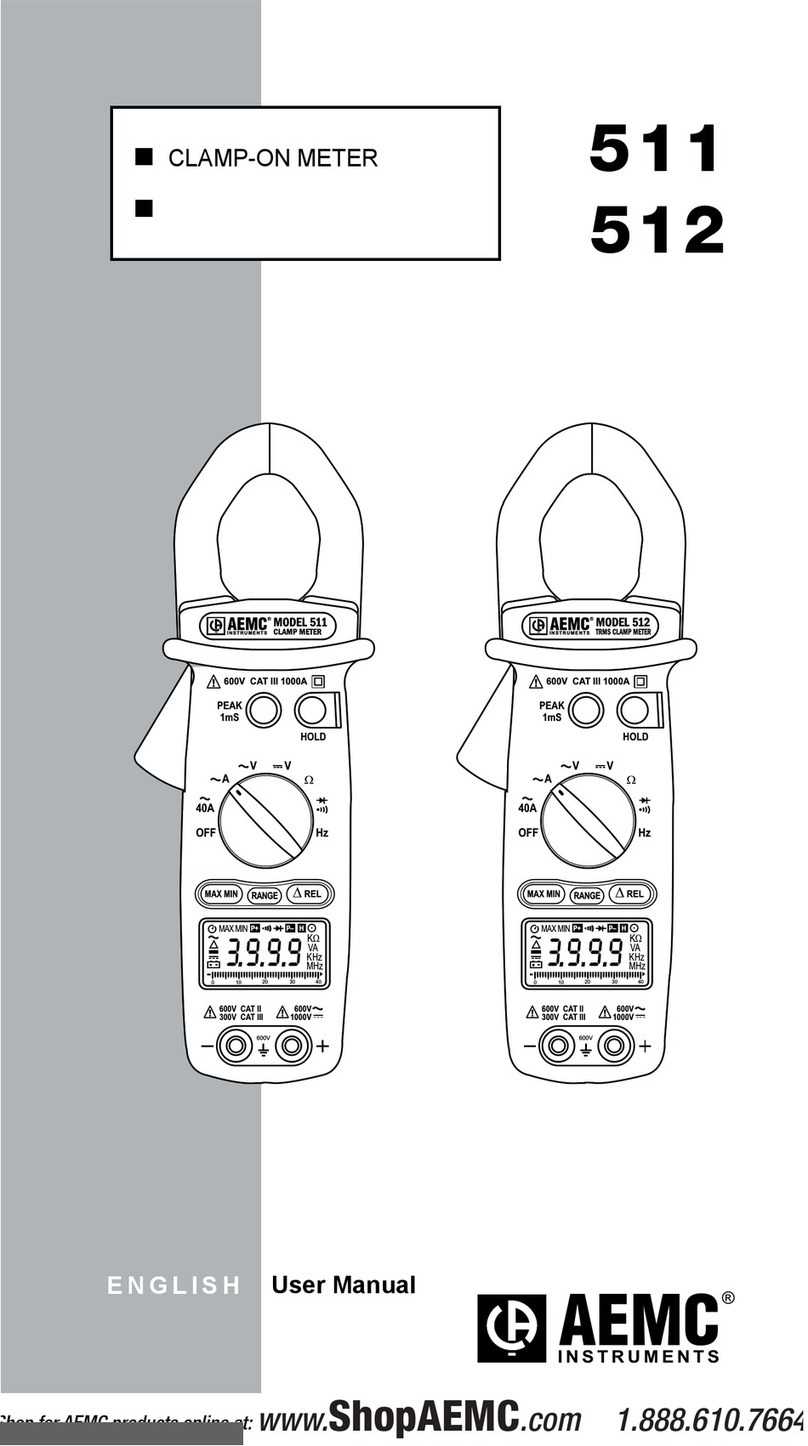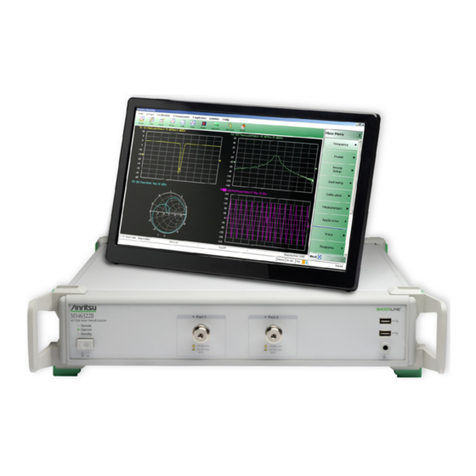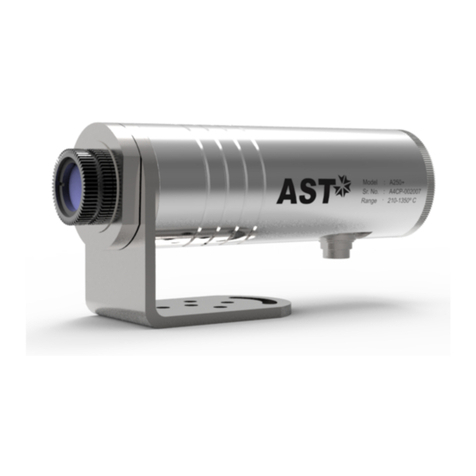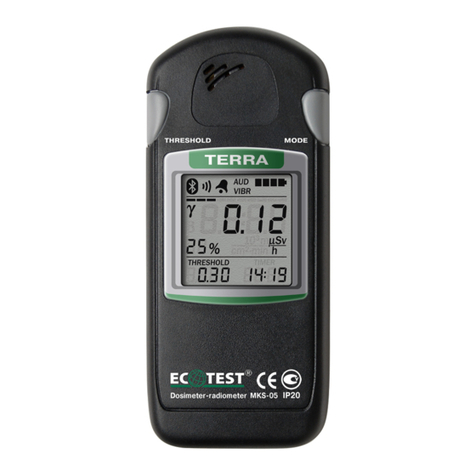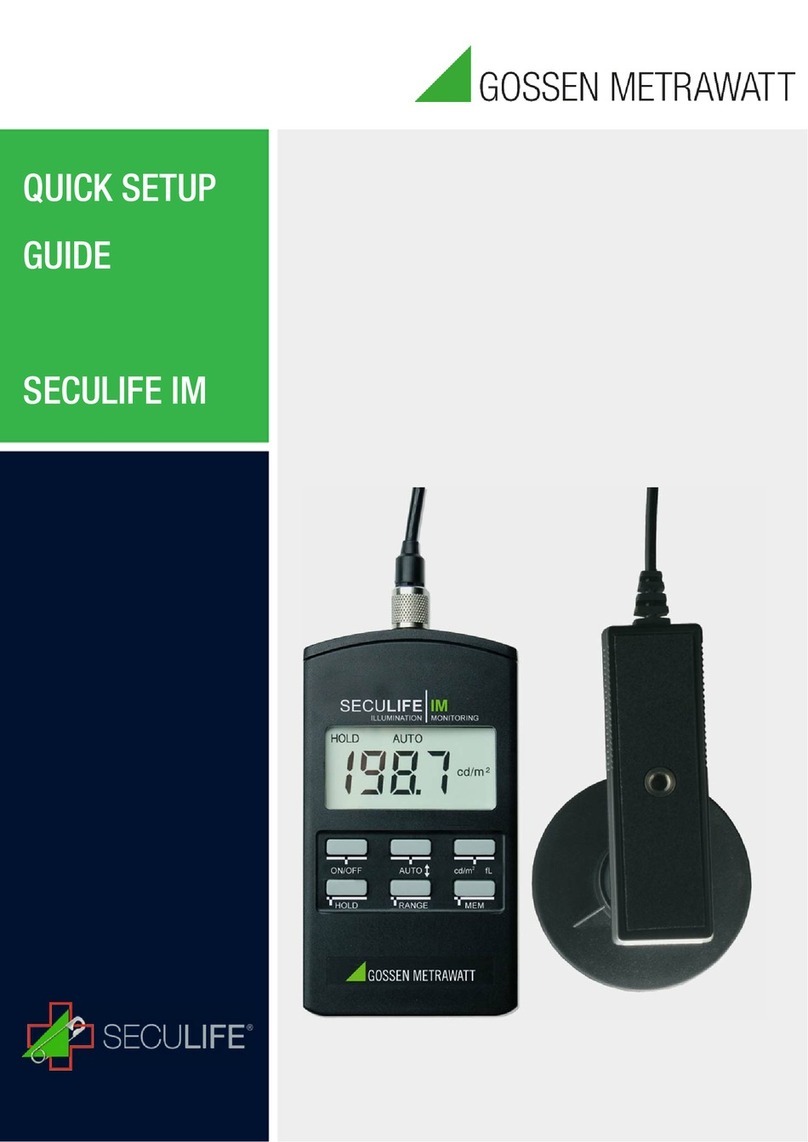Ossila T2006A User manual

USERMANUAL
Manual Version: 1.0.C
Product Code: T2006A
Product Version: 1.0
Software Version: 1.0
POTENTIOSTAT

Contents
1. Overview ..............................................................................................................4
2. EU Declaration of Conformity (DoC)............................................................5
3. Safety.....................................................................................................................8
3.1 Warning....................................................................................................................8
3.2 Use of Equipment.................................................................................................8
3.3 Hazard Icons...........................................................................................................8
3.4 General Hazards...................................................................................................8
3.5 Power Cord Safety................................................................................................9
3.6 Servicing...................................................................................................................9
3.7 Health and Safety – Servicing............................................................................9
4. Requirements.....................................................................................................9
5. Unpacking..........................................................................................................10
5.1 Packing List .......................................................................................................... 10
5.2 Damage Inspection........................................................................................... 10
6. Specications....................................................................................................10
7. System Components......................................................................................11
8. Installation.........................................................................................................12
9. Operation...........................................................................................................13
9.1 Taking a Measurement.................................................................................... 13
9.2 Software Settings and Controls.....................................................................14
9.3 Test Cell Chip....................................................................................................... 19
9.4 Performing Cyclic Voltammetry of Ferrocene..........................................20
9.5 Maintenance ....................................................................................................... 23
10. Troubleshooting............................................................................................24
11. Related products...........................................................................................25
11.1 Related Consumables.................................................................................... 25
11.2 Related Equipment......................................................................................... 25

4
1. Overview
Ossila’s Potentiostat is low-cost and easy-to-use system for performing cyclic voltammetry measurements.
Cyclic voltammetry is one of the most widely used electrochemical techniques, providing important
information about materials including:
• Reduction and oxidation potentials
• Reversibility of a reaction
• Electron transfer kinetics
• Energy levels of semiconducting polymers
The Potentiostat is capable of outputting potentials up 10 V, and measuring currents as low as 10 nA,
allowing for a wide range of material characterisation. The easy-to-use PC software included with the system
allows anyone to perform the measurement.

5
2. EU Declaration of Conformity (DoC)
We
Company Name: Ossila Limited
Postal Address: Solpro Business Park, Windsor Street.
Postcode: S4 7WB
City:
Telephone number: +44 (0)114 2999 180
declare that the DoC is issued under our sole responsibility
and belongs to the following product:
Product: Potentiostat (T2006A1)
Serial number: T2006A1-xxxx
Object of declaration:
Potentiostat (T2006A1)
The object of declaration described above is in conformity
with the relevant Union harmonisation legislation:
EMC Directive 2014/30/EU
RoHS Directive 2011/65/EU
Signed:
Name: Dr James Kingsley
Place:
Date: 01/10/2019

6
[Декларация] за съответствие на ЕС
[Čeština] Prohlášení o shodě EU
Výrobce: Ossila Ltd., Solpro Business Park, Windsor Street, S4 7WD, Spojené Království
[Dansk] EU-overensstemme lseserklærin g
Producent: Ossila Ltd., Solpro Business Park, Windsor Street, S4 7WD, UK
Erklærer herved, at vi alene er ansvarlige for, at det nævnte udstyr er i overensstemmelse med den relevante EU-
harmoniseringslovgivning, der er anført på den/de foregående side(r) i dette dokument.
[Deutsch] EU-Konformitätserklärung
Hersteller: Ossila Ltd., Solpro Business Park, Windsor Street, S4 7WD, Vereinigtes Königreich
Wir erklären in alleiniger Verantwortung, dass das aufgeführte Gerät konform mit der relevanten EU-Harmonisierungsgesetzgebung
auf den vorangegangenen Seiten dieses Dokuments ist.
[Eesti keel] ELi vastavusavaldus
Tootja: Ossila Ltd., Solpro Business Park, Windsor Street, S4 7WD, UK
Kinnitame oma ainuvastutusel, et loetletud seadmed on kooskõlas antud dokumendi eelmisel lehelküljel / eelmistel lehekülgedel ära
toodud asjaomaste ELi ühtlustamise õigusaktidega.
[Ελληνικά] Δήλωση πιστότητας ΕΕ
[Español] Declaración de conformidad UE
Fabricante: Ossila Ltd., Solpro Business Park, Windsor Street, S4 7WD, Reino Unido
Declaramos bajo nuestra única responsabilidad que el siguiente producto se ajusta a la pertinente legislación de armonización de la
UE enumerada en las páginas anteriores de este documento.
[Français] Déclaration de conformité UE
Fabricant: Ossila Ltd., Solpro Business Park, Windsor Street, S4 7WD, Royaume-Uni
Déclarons sous notre seule responsabilité que le matériel mentionné est conforme à la législation en vigueur de l’UE présentée sur la/
les page(s) précédente(s) de ce document.
[Hrvatski] E.U izjava o sukladnosti
navedeno na prethodnoj(nim) stranici(ama) ovoga dokumenta.
[Italiano] Dichiarazione di conformità UE
Produttore: Ossila Ltd., Solpro Business Park, Windsor Street, S4 7WD, UK
Si dichiara sotto la propria personale responsabilità che l’apparecchiatura in elenco è conforme alla normativa di armonizzazione UE
rilevante indicata nelle pagine precedenti del presente documento.
[Latviešu] ES atbils tības deklarācija

7
[Lietuvių k.] ES atitikties deklaracija
Gamintojas: Ossila Ltd., Solpro Business Park, Windsor Street, S4 7WD, UK
[Magyar] EU-s megfelelőségi nyilatkozat
Gyártó: Ossila Ltd., Solpro Business Park, Windsor Street, S4 7WD, UK
EU-s összehangolt jogszabályokra vonatkozó rendelkezéseinek.
[Nederlands] EU-Conformiteitsverklaring
Fabrikant: Ossila Ltd., Solpro Business Park, Windsor Street, S4 7WD, UK
Verklaart onder onze uitsluitende verantwoordelijkheid dat de vermelde apparatuur in overeenstemming is met de relevante
harmonisatiewetgeving van de EU op de vorige pagina(‘s) van dit document.
[Norsk] EU-samsvarserklæ ring
Produsent: Ossila Ltd., Solpro Business Park, Windsor Street, S4 7WD, UK
Erklærer under vårt eneansvar at utstyret oppført er i overholdelse med relevant EU-harmoniseringslavverk som står på de(n) forrige
siden(e) i dette dokumentet.
[Polski] Deklaracja zgodności Unii Europejskiej
Producent: Ossila Ltd., Solpro Business Park, Windsor Street, S4 7WD, UK
Europejskiej, które przedstawiono na poprzednich stronach niniejszego dokumentu.
[Por tuguês] Declaração de Conformidade UE
Fabricante: Ossila Ltd., Solpro Business Park, Windsor Street, S4 7WD, Reino Unido
Declara sob sua exclusiva responsabilidade que o equipamento indicado está em conformidade com a legislação de harmonização
relevante da UE mencionada na(s) página(s) anterior(es) deste documento.
[Română] Declaraţie de conformitate UE
prezentate la pagina/paginile anterioare a/ale acestui document.
[Slovensky] Vyhlásenie o zhode pre EÚ
uvedenými na predchádzajúcich stranách tohto dokumentu.
[Slovenščina] Izjava EU o skladnosti
Proizvajalec: Ossila Ltd., Solpro Business Park, Windsor Street, S4 7WD, UK
s polno odgovornostjo izjavlja, da je navedena oprema skladna z veljavno uskladitveno zakonodajo EU, navedeno na prejšnji strani/
prejšnjih straneh tega dokumenta.
[Suomi] EU-vaatimustenm ukaisuusvakuutus
Valmistaja: Ossila Ltd., Solpro Business Park, Windsor Street, S4 7WD, UK
Vakuutamme täten olevamme yksin vastuussa siitä, että tässä asiakirjassa luetellut laitteet ovat tämän asiakirjan sivuilla edellisillä
sivuilla kuvattujen olennaisten yhdenmukaistamista koskevien EU-säädösten vaatimusten mukaisia.
[Svenska] EU-försäkran om överensstämmelse
Tillverkare: Ossila Ltd., Solpro Business Park, Windsor Street, S4 7WD, Storbritannien
Vi intygar härmed att den utrustning som förtecknas överensstämmer med relevanta förordningar gällande EU-harmonisering som
fmns på föregående sidor i detta dokument.

8
3. Safety
3.1 Warning
• Do NOT connect external voltage sources to the WORKING channel.
• The absolute maximum input voltage for the REFERENCE channel is ±12 V.
• DO NOT apply input while not powered.
3.2 Use of Equipment
The Ossila Potentiostat is designed to be used as instructed. It is intended for use under the
following conditions:
• Indoors in a laboratory environment (Pollution Degree 2)
• Altitudes up to 2000m
• Temperatures of 5°C to 40°C; maximum relative humidity of 80% up to 31°C.
The unit is supplied with a 24 V / 2 A DC power adapter with a power cord for the country of purchase, in
accordance with European Commission regulations and British Standards. Use of any other electrical power
cables, adaptors, or transformers is not recommended.
3.3 Hazard Icons
The following symbols can be found at points throughout the manual. Note and read each warning before
attempting any associated operations associated with it:
Table 3.1. Hazard warning labels used in this manual.
Symbol Associated Hazard
Electrical shock
3.4 General Hazards
Before installing or operating the Ossila Potentiostat, there are several health and safety precautions which
must be followed and executed to ensure safe installation and operation.

9
3.5 Power Cord Safety
3.7 Health and Safety – Servicing
4. Requirements
3.6 Servicing
Table 4.1. Potentiostat and Ossila Cyclic Voltammetry software requirements.
Emergency power disconnect options: use the power cord as a disconnecting method
and remove from wall. To facilitate disconnect, make sure the power outlet for this cord is
readily accessible to the operator.
alteration may damage the equipment, cause injury, or death. It will also void your
equipment’s warranty.
If servicing is required, please return the unit to Ossila Ltd. The warranty will be invalidated if:
•
• The unit has been subjected to chemical damage through improper use.
• The unit has been operated outside the usage parameters stated in the user documentation
associated with the unit.
• The unit has been rendered inoperable through accident, misuse, contamination, improper
Table 4.1
Ossila Cyclic Voltammetry software.
Power 24 V / 2 A DC (supplied with the system)
Operating Systems Windows Vista, 7, 8, or 10 (32-bit or 64-bit)
CPU Dual Core 2.5 GHz
RAM 2 GB
Available Hard Drive Space 110 MB
Monitor Resolution 1280 x 900
Connectivity USB 2.0

10
5.1 Packing List
5.2 Damage Inspection
The standard items included with the Ossila Potentiostat are:
• The Ossila Potentiostat.
•
• Cell connection cable.
• USB-B cable.
• USB memory stick pre-loaded with the user manual, USB drivers, QC data, and Ossila Cyclic
Voltammetry software installer.
• Printed copy of the user manual.
• Test cell chip.
Examine the components for evidence of shipping damage. If damage has occurred, please contact Ossila
directly for further action. The shipping packaging will come with a shock indicator to show if there has been
any mishandling of the package during transportation.
Table 6.1 below.
6. Specications
Table 6.1.
Potential range ±7.5 V
Potential compliance ±10 V
Applied potential resolution
Applied potential accuracy
Maximum current ±150 mA
Current ranges ±10 nA to ±150 mA (5 ranges)
Communication USB-B
Overall Dimensions Width: 125 mm, Height: 55 mm, Depth: 175 mm
Weight 600 g
5. Unpacking

11
The Ossila Potentiostat comprises four items: the Ossila Potentiostat, banana cables, power adaptor, and
Ossila Cyclic Voltammetry software.
7. System Components
Figure 7.1. Ossila Potentiostat.
Figure 7.2. Cell connection cable.
Figure 7.3. The 24 V DC power adapter.

12
Note: The Ossila Cyclic Voltammetry software and SMU USB drivers can also be downloaded from
ossila.com/pages/software-drivers
8. Installation
1. Install the Ossila Cyclic Voltammetry software on your PC.
II. Follow the on-screen instructions to install the software.
2. Install the USB drivers on your PC.
I. On the USB memory stick provided, open the ‘SMU-Driver’ folder and run either ‘Windows
32-bit SMU Driver’ for 32-bit operating systems or ‘Windows 64-bit SMU Driver’ for 64-bit
operating systems.
II. Note, on Windows 10 the drivers will install automatically when the unit is connected.
III. If the drivers fail to install, please refer to the SMU USB Driver Installation Guide found on the
USB memory stick.
3. Connect the 24 V / 2 A DC power adaptor to the power socket on the rear of the unit.
4. Connect the unit to your PC using the provided USB-B cable.
I. If you are using a USB connection and the unit is not detected, please refer to the SMU USB
Driver Installation Guide found on the USB memory stick.
Figure 7.4. Ossila Cyclic Voltammetry PC software.

13
Start Potential Potential Vertex 1 Potential Vertex 2 Start Potential
Figure 9.1.
potential vertex 2 of -0.5 V, and scan rate of 100 mV/s.
9. Operation
1. Add your appropriate electrolyte solution into the electrochemical cell.
2. Place the lid on the cell and insert the working, counter, and reference electrodes.
3. Use the cable and crocodile clips to connect the sockets on the front of the Potentiostat to the
appropriate electrodes.
I. The red clip connects to the working electrode.
II. The black clip connects to the counter electrode.
III. The blue clip connects to the reference electrode.
4. Start the Ossila Cyclic Voltammetry software. The window shown in Figure 9.2 will open.
5. Enter the appropriate settings for your experiment into the software (explained in more detail in
Section 9.2).
6. Click the ‘Measure’ button.
I. The system will sweep the potential between the working electrode and reference electrode,
whilst measuring the current between the working electrode and counter electrode, in the
follow steps:
7. If ‘Save After Measurement’ is turned on, the measurement data and settings will be saved once the
sweep has completed.
9.1 Taking a Measurement

14
There are several settings in the software which must be entered before taking a measurement. These are
found on the panel to the left of the window as shown in Figure 9.2.
9.2 Software Settings and Controls
9.2.1 Measurement Settings
Figure 9.2. Ossila Cyclic Voltammetry software.
Figure 9.3. Measurement settings.
(I) Connected Systems
• Select the COM port of the connected unit you intend to use.
I. This box will be populated automatically with the addresses of any units connected to the
computer when the software starts.
II. To rescan for connected units (in case the connection is changed) click the refresh icon next to
the drop-down box.

15
9.2.2 Saving and Loading Settings
Figure 9.4.
(II) Current Range
• Select the range of currents to be used for the measurement or automatic range selection.
performed by the system.
II. Automatic range selection will start on the lowest current range and automatically switch to
higher ranges if the current increases above the maximum for a range.
(III) Start Potential (V)
• The potential in volts at which the measurement starts.
(IV) Potential Vertex 1 (V)
•
(V) Potential Vertex 2 (V)
• The second potential in volts at which the scan changes direction.
(VI) Scan Rate (mV/s)
• The rate at which the potential will be changed during the scan, measured in millivolts per second.
(VII) Cycles
• The number of times the scan will be repeated.
(I) Save Settings
•
•
II. The name cannot contain the characters: \ / : * ? “ < > |
III. You can change the default settings by choosing the name ‘Default’.
•

16
9.2.3 Measurement Controls
9.2.4 Graph Controls
(II) Settings Proles
•
•
drop-down box.
Figure 9.5. Controls to start and stop the measurement.
Figure 9.6. Readout of the potential and current at the mouse cursor location.
(I) Measure
• Clicking this button will start the measurement using the chosen settings.
• This button cannot be clicked if the software has not detected a unit.
(II) Abort
• Stops a measurement that is currently in progress.
(I) Potential and Current Readout
• Whilst the mouse cursor is over the graph, the potential and current of its location are displayed to the
bottom-right of the graph, as shown in Figure 9.6.

17
(II) Graph Display Controls
By default, the graph will automatically scale the axes of the graph to display all the data within it. The view
can be controlled manually using the following mouse controls:
• Left/Middle click and drag – pan the axes.
• Right click and drag – scale the axes.
• Scroll wheel – scale the axes.
the ‘A’ button in the bottom-left of the graph, as shown in Figure 9.7.
(III) Selecting and Removing Curves
When there are multiple curves on the graph, one of them is considered the active curve. This curve will be
displayed in blue, whilst the other curves will be grey. By default, the last curve to be measured is the active
curve. You can change which curve is the active curve by clicking on any curve using the left mouse button.
To remove an individual curve from the graph, click on it using the left mouse button to make it the active
curve, then press the Delete key.
Figure 9.7. Button to reset the graph axes.
Figure 9.8. Controls for the graph.

18
9.2.5 Saving Results
Figure 9.9. Saving results.
(IV) Clear Graph
• Removes all data from the graph.
(V) Display Maximum/Display Minimum
• Highlights the maximum or minimum point of the active curve and displays the potential and current
values of the point.
(I) Save After Measurement
• The program allows for data to be saved automatically, as well as manually once the measurement
is complete.
measurement can start, these are detailed below.
(II) Save Directory
• Sets the location in which to save the results.
• This can be set either by:
to save to.
(III) Sample Name
•
I. The name cannot contain the characters: \ / : * ? “ < > |
(IV) Save Selected
• Clicking this button will manually save the measurement results of the active curve.

19
(V) Save All
• Clicking this button will manually save all the measurement results that are currently displayed in
the graph.
The Ossila Potentiostat includes a Test Cell Chip, shown in Figure 9.10, which can be used to check that your
depending on the direction of the potential scan.
9.3 Test Cell Chip
Figure 9.10. Ossila Test Cell Chip.
Figure 9.11. Settings for measuring the Test Cell Chip.
9.3.1 Taking a Measurement
1. Plug in and turn on the Potentiostat.
2. Use the cell connection cable to connect the Potentiostat to the same colour connectors on the
Test Cell Chip.
I. Red connector to WE1, 2, 3, or 4.
II. Black connector to CE.
III. Blue connector to RE.
3. Start the Ossila Cyclic Voltammetry software. The window shown in Figure 9.2 will open.
4. In the software enter the settings shown in Figure 9.11.
5. Click the ‘Measure’ button.

20
For the WE3 connector, if the Potentiostat is working and the measurement has been set up correctly, you
will see the response shown in Figure 9.12.
WE1 and WE2 will give responses that are the same shape as WE3, but with maximum currents of
approximately 30 nA and 100 nA respectively. WE4 is a simple resistor and will produce a straight line from
Figure 9.12. Example voltammogram for WE3 on the Test Cell Chip.
Here we will give an example on how to prepare a simple electrochemical cell to take a measurement of
ferrocene (Fc), which is the standard reference used for cyclic voltammetry.
(I) Before Starting
We recommend switching on the Potentiostat 30 minutes prior to use. This allows it to warm up and reach a
stable temperature, ensuring a stable measurement.
Furthermore, ensure that all apparatus, solvents and electrolytes are dry. This is because the presence
of water and its redox by-products may reduce the solvent potential window or react with the solvent or
analyte.
(II) Clean and Dry the Electrochemical Cell and Electrodes
The cell and electrodes should always be thoroughly rinsed immediately after each experiment with the
solvent that was used in your electrolyte. Always set the cell to dry, preferably in an oven, before you prepare
your electrolyte. This helps reduce contamination of your solution.
9.4 Performing Cyclic Voltammetry of Ferrocene
9.4.1 Preparing an Electrochemical Cell

21
(I) Start-up Procedure
Please allow 30 minutes for the potentiostat to warm up after turning on. Once warmed up, start the Ossila
Cyclic Voltammetry software. Ensure that the potentiostat is detected by the software. If it is, the “Connected
Systems” drop-down box will be populated, and the “Measure” button will be green. If there is nothing
in the “Connected Systems” drop-down box and the “Measure” button is greyed out, please refer to the
troubleshooting guide in Section 10.
9.4.2 Taking a Measurement
(III) Prepare the Electrolyte Solution
background electrolyte, but other electrolyte salts and solvents can be used. The solvent and electrolyte
choice are determined by the solvent potential window and the solubility of your analyte. Most electrolytes
are hygroscopic, so should be stored in a desiccator or inert atmosphere.
stir until the electrolyte has dissolved.
Secure the electrochemical cell with a clamp to ensure it is stable before adding the 20 ml of electrolyte
solution. Once dissolved, add approximately 10 mg of Fc to the solution and stir to dissolve it.
(IV) Set up the Electrodes
Place the cap on the electrochemical cell, then insert the working and counter electrodes into two of the
holes. We will now prepare the reference solution; a 0.01 M solution of silver nitrite in acetonitrile. Prepare
(V) Degas the Solution
Gently bubble inert gas through the solution using a thin tube or needle for approximately 10 minutes to
remove dissolved oxygen.
(VI) Connect the Potentiostat and Cell
Use the cable to connect the Potentiostat and electrodes. The connector colour corresponds to which
electrode it connects to:
• Red -> Working electrode
• Black -> Counter electrode
• Blue -> Reference electrode
Table of contents
Other Ossila Measuring Instrument manuals
